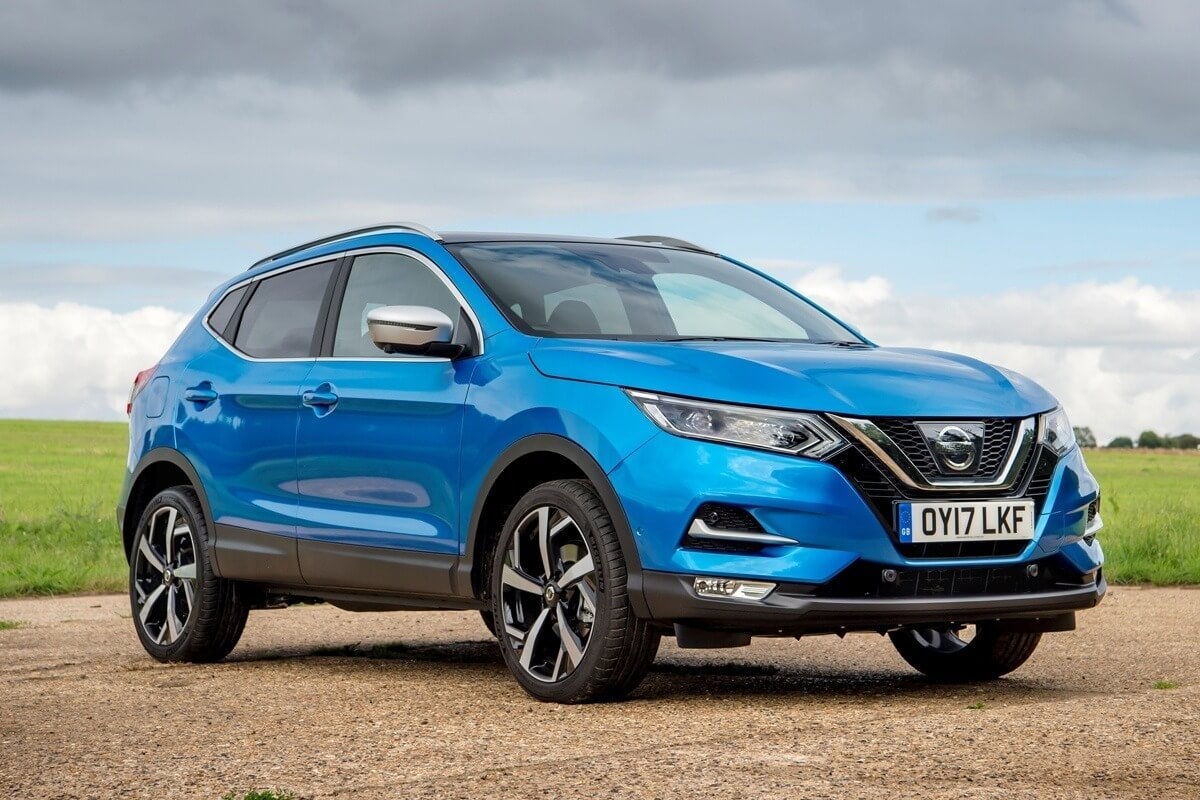Ford Kuga (2013-2020) Review
Written by Andrew Brady
Quick overview
Pros
- One of the most engaging family SUVs to drive
- Popularity when new means lots of choice second-hand
- Usual Ford reliability and value for money
Cons
- Ride quality is firm
- Interior not as luxurious as some alternatives
- Styling doesn’t have the charm of the original
Overall verdict on the Ford Kuga
"In this Ford Kuga review we're looking at a popular SUV from a manufacturer not typically associated with the sector. The Ford Kuga ticked the relevant boxes for the customers - it's spacious and practical - but also delivered the typical Ford values in being good to drive too. Plus you get the usual factors when buying a Ford, namely that there's loads around so you can easily find a good one, which makes it an appealing used purchase."
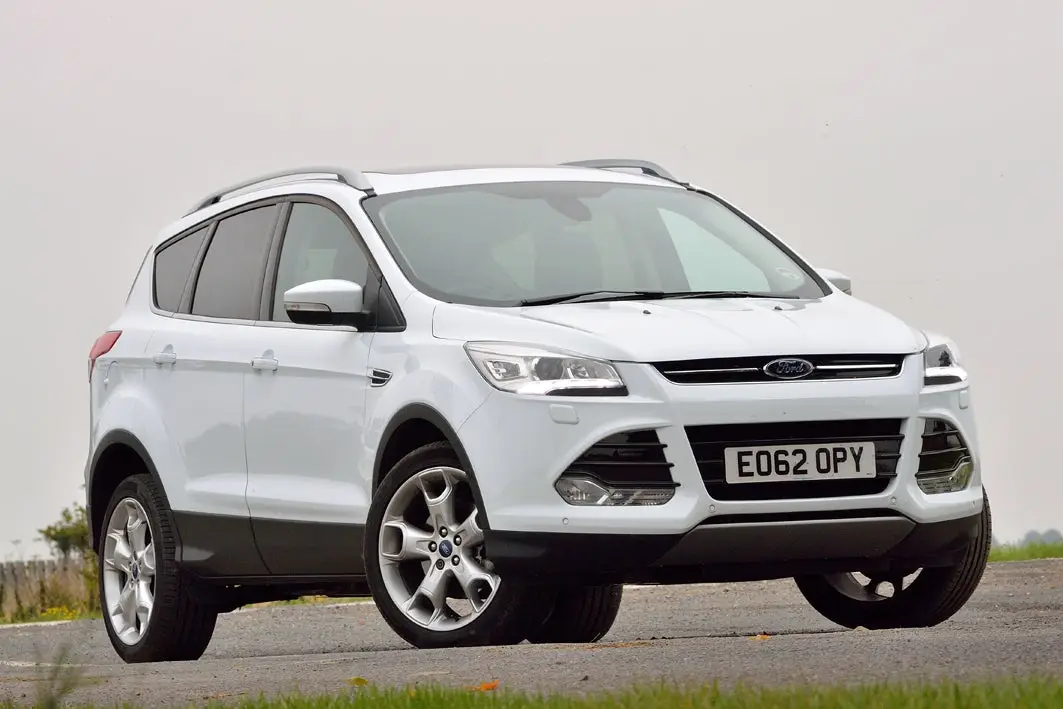
There's a new generation Ford Kuga these days, but for those of us on a smaller budget it's worth considering the previous version.
The Ford Kuga has been a real hit for Ford. The first generation car was launched in 2008 and was an unexpected surprise. It had chunky good looks, an interesting interior and, most importantly, fun and engaging road manners.
This second-generation model came along in 2013. It doesn’t quite have the charismatic styling of the original, but is a bigger and more commanding car overall. It also benefits from a more spacious and flexible interior. The engine range is broad, yet little of the driving charisma evident in the first Ford Kuga has been lost.
The secret sauce is the combination of Ford familiarity, including an extensive dealer network, plus the appeal of stepping into the ever-growing SUV sector. We’re certain more than a few Ford Focus hatchback buyers have traded up into a Ford Kuga come PCP renewal time. The Ford Kuga has the lofty driving position, rugged stance and general sense of up-high superiority you get from the best SUVs. A Focus will never feel quite the same after driving a Ford Kuga.
The broad range of engines is centred on diesels. While buyers of smaller Ford cars prefer the 1.0-litre Ecoboost petrol engine, it’s not quite beefy enough to power a Ford Kuga. The 1.6-litre TDCi and later 1.5-litre TDCi diesels sell particularly well, and there’s a range of 2.0-litre TDCi versions for those who want more power.
Many find they do indeed want that, because the Ford Kuga is such a fun SUV to drive. It has all the charm of the fine-handling Focus, just from a higher seating position. Compared with some of its softer, soggier rivals, it’s amazing how much sportier the Ford Kuga feels, with sharp steering, little body-roll and great control even when you’re throwing it around.
Neat gadgets include one of the first electrically-operated tailgates available on a new car. Now commonplace, the Ford Kuga got it before many others, including the sensor under the rear bumper that automatically opens it when you wave your foot there. Experience tells us it’s a bit hit-and-miss though...
Trims have become increasingly lavish throughout Ford Kuga’s life. Sporty versions include the launch of the bold ST-Line when the car was facelifted in early 2016 (spot these from the much bolder wide-bar grille). An ultra-posh Ford Kuga Vignale followed a few months later. Ford also gave a big boost to infotainment with the 2016 facelift, introducing the Ford Sync 2 media system. It’s really slick and simple to use, and includes a crisp-looking touchscreen. It’s a big improvement over the launch Sync set-up.
The Ford Kuga won’t be for everyone. Some will certainly find the ride a bit on the firm side, a consequence of its agile handling. Others may prefer the charismatic styling of the original, or the more premium take of alternatives such as the Volkswagen Tiguan. Yet hundreds of thousands of buyers mean there is a huge choice on the second-hand market – and help underline what a success Ford’s second-generation family SUV has been.
If you're looking for the newer version, you need our Ford Kuga review.
Is the Ford Kuga right for you?
A used Ford Kuga certainly has space and practicality on its side. It looks commodious because it’s high off the ground and has a long body – and so it proves. It’s an obvious step up compared to a hatchback, with more accommodating rear seats and a more practical boot.
It feels good behind the wheel, too. The loftily-positioned seats offer a clear view of the road ahead. Versions with the Sync 2 system are particularly good here, because the dashboard is easier and more sophisticated to use.
If you enjoy driving but have decided you need to compromise by switching to an SUV, check out the Ford Kuga. You’ll discover there’s hardly any compromise in the part you value most. Ford’s diesel engines are all pretty decent, and the Ecoboost petrols are a lot of fun, albeit saddled with thirstier fuel consumption to match.
What’s the best used Ford Kuga model/engine to choose?
We certainly think diesel is best with the Ford Kuga. The 1.6-litre TDCi engine is fine for easygoing family use, and the later enhanced 1.5-litre TDCi is better still (it sounds like it should be the other way around, but the smaller motor – which arrived in 2016 – is worth making the jump into).
The powerful 2.0-litre TDCi engines are also good, particularly for those who cover high mileages or carry heavier loads. It’s more effortless and you won’t have to work it so hard, which gives it a more relaxing feel.
As for model grades, even a basic Zetec has sporty touches, but we like the extra equipment you get in a Titanium-spec Ford Kuga. Our favourite of all is ST-Line, which has styling details almost befitting of a hot hatchback.
What other cars are similar to a Ford Kuga?
You have no shortage of choice in the family-sized SUV sector. There’s the Volkswagen Tiguan, Nissan X-Trail (and Qashqai), popular Kia Sportage and comfortable Vauxhall Grandland X…
Not to mention others such as the Hyundai ix35 and Tucson, practical Peugeot 3008, sporty SEAT Ateca, Honda CR-V and more. You name a brand and there’s a fair chance it offers a car similar to the Ford Kuga.
The Ford Kuga sits above the smaller Ecosport and excellent Puma within the Ford range, and below the short-lived Edge, and the fact that it has proved hugely more popular than either says it all.
Comfort and design: Ford Kuga interior
"Chunky, bold looks on the outside are matched by an interior that offers a slightly sportier take than the SUV norm. Drivers face a good-to-hold leather steering wheel and deeply-cowled dials, making it feel more like a Focus ST than a tall, five-seat SUV. The gear lever is mounted high up and seems to encourage quick, snappy shifts."
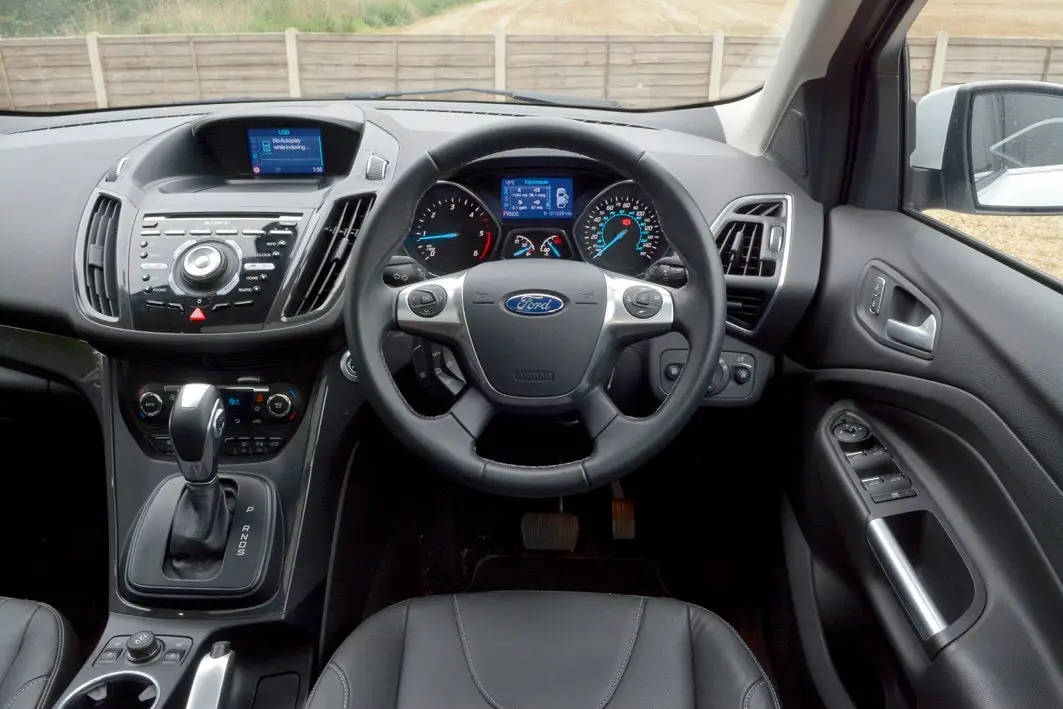
The seats are firm and supportive, particularly the more bolstered chairs you get in the ST-Line. Again, you sense a bit of hot hatch in them. The driving position is, typically for a Ford, very well laid out, and seems a bit more natural than some SUVs – some of which feel a bit van-like. It immediately puts you in a good mood and eager to discover how well it drives.
The touchscreen is mounted nice and high on the dashboard. For cars fitted with Sync 2, it looks particularly modern, with the screen boasting good resolution and clarity. Shame the same can’t be said for some of the other controls.
Mounted below the screen is a mass of buttons for the climate control, a layout further cheapened by the muddy blue LED glow of the temperature readouts. The buttons on the steering wheel are also baffling, and make using the trip computer a struggle.
Overall, the Ford Kuga’s interior design is more interesting than the usual SUV offering, with bold angles and some interesting contrasts in trim materials. That the fundamentals are sound – good comfort and an excellent layout – shows that Ford didn’t forget the basics when laying it out.
Quality and finish
Ford is a mainstream brand, not a premium manufacturer. So, compared with something like a Volkswagen Tiguan, the materials don’t have the same smooth feel or rich appearance. The plastics are just a touch shinier and more utilitarian.
Don’t get us wrong, it’s all very well built, with the solidity you’d expect of a popular brand such as Ford. There shouldn’t be any rattles or obvious feeling of flimsiness, but, whereas Volkswagen might apply a nice soft-touch, low-sheen finish to a doorhandle, Ford simply screws on the plastic fitting as is. The materials are just that bit more workmanlike.
Quality is apparent in other ways, such as the good-looking instruments, the beautifully-finished steering wheel and even the quality of the gearshift. The Sync 2 screen is a smart design, too. Ford arguably beats even later Volkswagen systems in this regard.
Infotainment: Touchscreen, USB, nav and stereo in the Ford Kuga
Infotainment wasn’t the strongest facet of the Ford Kuga when it was launched in 2013. The original Sync system was very involved to use, with confusing menus and little apparent logic. The screen was also small, at just 5.0 inches, and it looked cheap. Even built-in voice control didn’t make it any easier to use. Indeed, its predecessor seemed to have a better set-up here.
This was all fixed in 2016 when the radically improved Sync 2 system arrived. It immediately looked much better, as it had a far larger 8.0-inch touchscreen. It is sharper and more colourful in appearance, with improved definition. Advanced connectivity vastly improved the voice control, and it became more comprehensive, with easy switching between navigation, entertainment, telephone and other settings.
The built-in navigation is far easier to use than earlier versions, helped in no small part by the crisp touchscreen. Directions can be repeated in the colour display positioned between the dials ahead of the driver, although the logic of the steering wheel buttons still leaves a little to be desired.
Space and practicality: Ford Kuga boot space
Interior space is where the Ford Kuga offered a big step forward over the original – particularly in terms of boot size. The first Ford Kuga had a boot that held just 360 litres. This was very small, little better than a Ford Focus, and it left the car lagging behind contemporary rivals. Some buyers even rejected the Ford Kuga out of hand because of its small boot.
Ford knew it had to respond, which is why this second-generation Ford Kuga is so much longer and larger than the original. Load capacity grew to 456 litres – an improvement of almost 30 percent – and the boot is a good shape with no lumpy sill to lift heavy objects over. It is simply a matter of popping the tailgate and sliding things in. If you do need more space, the two-level boot floor drops down a level.
The electric operation was novel, too. Most people simply used the button on the bootlid to operate it, or the remote control, but the foot-sensing gadget was there to magically open the tailgate if your hands were full.
The rear seats fold at the press of a button, which is a much simpler affair than before. The load space opens up to 1,603 litres, and the seats fold flat, so it’s a practical and convenient space. Just be aware that if you choose a full-size spare wheel, boot space does decrease, but at least Ford offers the option.
Rear-seat comfort is good. The Ford Kuga has a nice and accommodating bench seat with lots of headroom and footroom beneath the front seats. It’s comfortable and supportive, with only the middle-seat passenger perhaps complaining about feeling a bit perched. The near-flat floor does help declutter space for feet, though.
Some higher-spec Ford Kugas have smart LED interior lighting, which bathes the cabin in a welcoming and bright glow – ideal for those in the rear who want to read on long journeys. The rear-seat backrests recline as well, and there are dual ISOFIX mounts for child car seats on the outer two chairs.
Handling and ride quality: What is the Ford Kuga like to drive?
"Handling is the headline act of the Ford Kuga. It is a key reason why some will choose it over a rival, because it shows that SUVs don’t have to be staid and boring, and can provide twisty-road entertainment that’s almost a match for a more conventional hatchback. Whether the family will appreciate you demonstrating this is another matter."
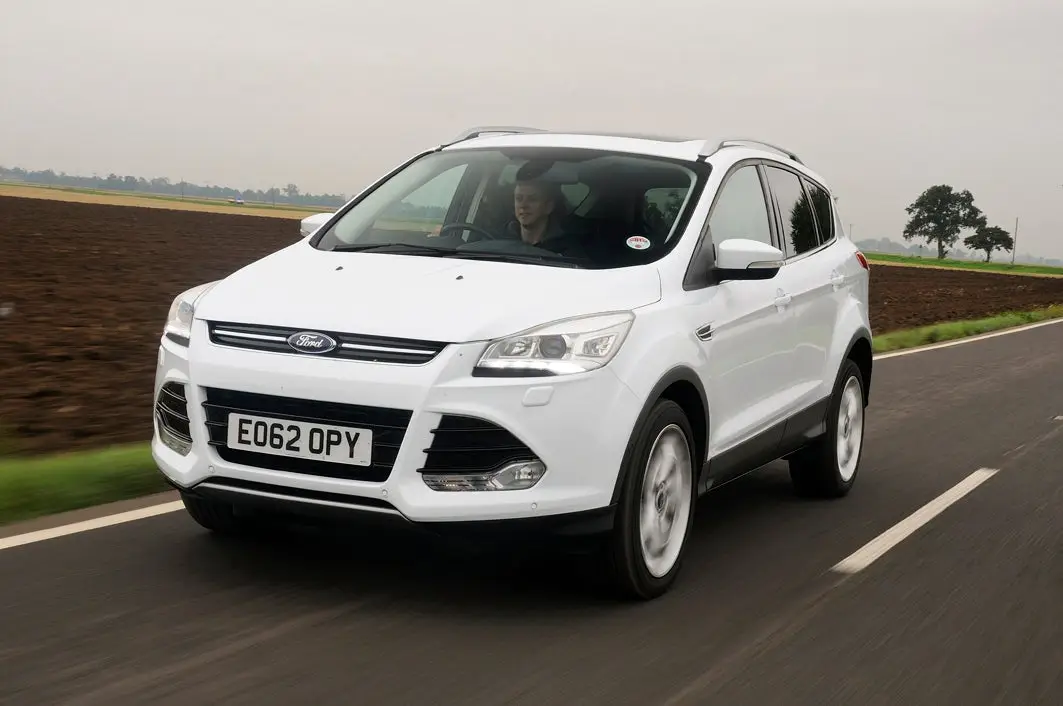
Response through that chunky leather steering wheel is excellent, with the Ford Kuga proving alert and agile through bends. There’s little body-roll and it seems to respond immediately to inputs, so you can feed it between corners at pace without feeling like the body’s struggling to catch up. There’s lots of grip too, and good traction from models with all-wheel drive (regular Ford Kugas are front-wheel drive).
It is also stable at speed, with a confident and planted feel on the motorway. It never feels loose or soggy, and this reassurance helps make long journeys that bit easier.
There is a pay-off for this enthusiasm, though: ride quality. Even on models with standard-sized alloy wheels, it’s taut. The set-up is firmer than in many SUVs, and leads to a bit more joggle over bumps than you find in other, more cushioned alternatives. Generally, it’s composed, but it can be caught out by bumps.
Models with 18-inch and 19-inch wheels are rather choppier, though. At times, ride comfort borders on harsh, as the sporty profile of the tyres picks out faults in the road surface and transfers them straight to the passengers within. Choose carefully if you’re seeking a car that will keep the family happy, as well as yourself.
What engines and gearboxes are available in the Ford Kuga?
Ford offered both petrol and diesel engines at the launch of the second-generation Ford Kuga, but it is diesels that have proven by far the most popular choice – helped by mediocre fuel economy of barely 36mpg from some of the early turbo petrols.
The range was originally built around the 2.0-litre TDCi, which was offered in 140PS and 163PS guises. Ford sold a fuel-saving front-wheel drive version, with the others coming in all-wheel drive guise. Automatic gearboxes can be found on the second-hand market, although most were sold with a six-speed manual – and boast the typically slick gearshift of most Ford cars.
Engines were improved in 2015, with 150PS and 180PS 2.0-litre TDCi diesels, plus a much more fuel-efficient 1.5-litre Ecoboost turbo petrol that came in 150PS and 182PS formats. A little later, Ford introduced the 1.5-litre TDCi that, for many, is the best engine overall. It is economical, smooth-running and performs more strongly than its headline 120PS power output suggests. This engine could also be had with an automatic gearbox, although be wary: not only is it significantly slower than the manual, it’s also far less fuel efficient.
Refinement and noise levels
Ford Kuga refinement isn’t bad. It’s a large car, and this seems to deliver better isolation from the road surface than the general family hatchback norm. The biggest grumble might be the noise from lumps and bumps that you get from models with larger wheels, and the tyre roar they can generate at higher speeds.
Engine refinement very much depends on which era of Ford Kuga you choose. The early 2.0-litre TDCi motors were okay, but could be a bit rattly, particularly when first started up. Things improved through the Ford Kuga’s life, with the later more powerful 2.0-litre diesels and 1.5 TDCi proving better in this respect. Diesel engines also don’t have to be revved as much, which keeps noise levels down.
The eager petrols are very smooth, and the turbocharged pull from the 1.5 Ecoboost again certainly appeals. They do have a sporty growl when worked harder, though, which perhaps isn’t entirely fitting in a family-focused machine like this.
Safety equipment: How safe is the Ford Kuga?
As well as a comprehensive collection of standard airbags (including a driver’s knee airbag), all Ford Kugas with sat-nav come with a comprehensive emergency assistance system. This was built into even the early Sync set-up, then further enhanced with Sync 2. It uses airbag sensors and other crash sensors to automatically alert the emergency services in the event of an accident. If the driver is incapacitated, it even sends the GPS location of the Ford Kuga to the rescue team, so the car can be found.
Later models were available with an enhanced Active City Stop – and it came as standard on the Ford Kuga Vignale. This detects obstacles ahead (both stopped cars as well as pedestrians) and will alert the driver. If they don’t respond, it automatically applies the brakes, potentially avoiding an impact altogether.
Ford even introduced the option of adaptive front lighting, which could automatically adjust the angle of the headlights in heavy rain to spot obstacles at the roadside.
In 2012, Euro NCAP awarded the Ford Kuga a five-star rating, with an excellent 94% score for adult occupant protection, plus 86% for child occupant safety. Even better, a full 100% for safety assist features was awarded, along with 70% for pedestrian protection. All five seats have a seatbelt reminder and a speed limiter device is standard.
MPG and fuel costs: What does a Ford Kuga cost to run?
"Average economy improved a lot during the second-generation Ford Kuga’s lifetime. This helped reduce fuel costs for later versions, which is worth bearing in mind when you’re looking for second-hand models."
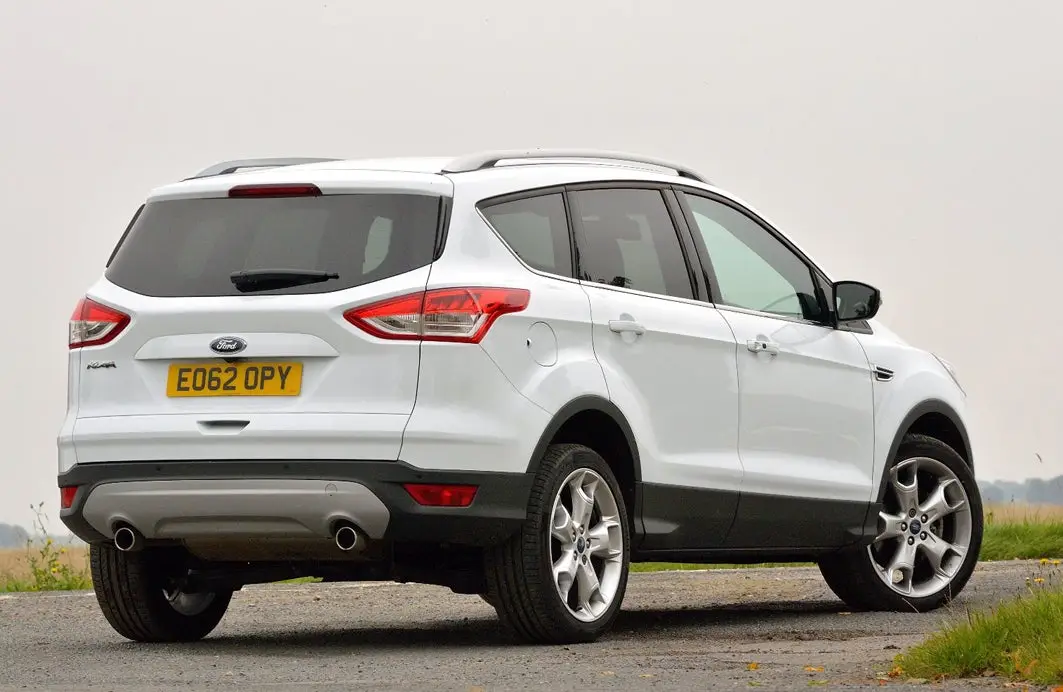
Avoid the early 1.6T Ecoboost. It couldn’t even average 37mpg on the official cycle. Front-wheel-drive versions were better, but even they barely achieved 43mpg. This pales alongside the 49.6mpg of the 2.0 TDCi 140 diesel, with a front-wheel drive version of this model managing over 53mpg.
The 1.5-litre EcoBoost petrols were better, and could deliver upwards of 45mpg in front-wheel drive form. So too were the 1.5 TDCi diesels, with the regular version topping 64mpg, and even the auto returning 58.9mpg. If you want to keep Ford Kuga fuel costs as low as possible, choose a 1.5 TDCi 120.
How reliable is a Ford Kuga?
The Ford Kuga scored a remarkable 9.76 out of 10 for reliability in the HonestJohn.co.uk Satisfaction Survey, making it one of the best-performing Fords recorded.
Less impressive is Ford's performance as a brand, finishing 26th out of 30 overall in the same survey. However it does appear that the Ford Kuga bucks the trend of other Ford products, so you can buy with a bit more confidence.
Insurance groups and costs
Insurance groups range from 14 to 27 for the Ford Kuga. This is pretty good by class standards, showing the theft resistance and economical accident repair costs inherent in the Ford brand.
The 1.5 TDCi is the most affordable, with many versions (even the ST-Line) coming in at group 15. Our preferred 150PS 2.0 TDCi starts at group 22 for Zetec trim, with the Titanium in group 23. Petrol models are a little pricier, reflecting their greater performance, as are high-spec versions such as the Ford Kuga Vignale.
VED car tax: What is the annual road tax on a Ford Kuga?
Take care with petrol versions if you’re seeking the most affordable VED (road tax). Higher rates of CO2 place them into steep tax bands, so they can cost £360 a year in all-wheel-drive automatic form.
You’re better off sticking with diesel. A front-driven 2.0 TDCi costs up to £220 a year to tax, and the later 1.5 TDCi is usually £165.
Note that Ford Kugas from 2017 onwards will be subject to the revised VED regime, with a £165 standard rate (applicable as no Ford Kuga then cost more than £40,000).
How much should you be paying for a used Ford Kuga?
"For a second-generation Ford Kuga, you’ll need around £8000 to get an early 2015 car. It will likely be a 2.0-litre TDCi Zetec (or, less commonly, a Titanium) and have around 60,000 miles on the clock. The 2014 and 2015 models call for a budget from around £9000, as do petrol-engined cars – which are rarer as fewer were sold when new."
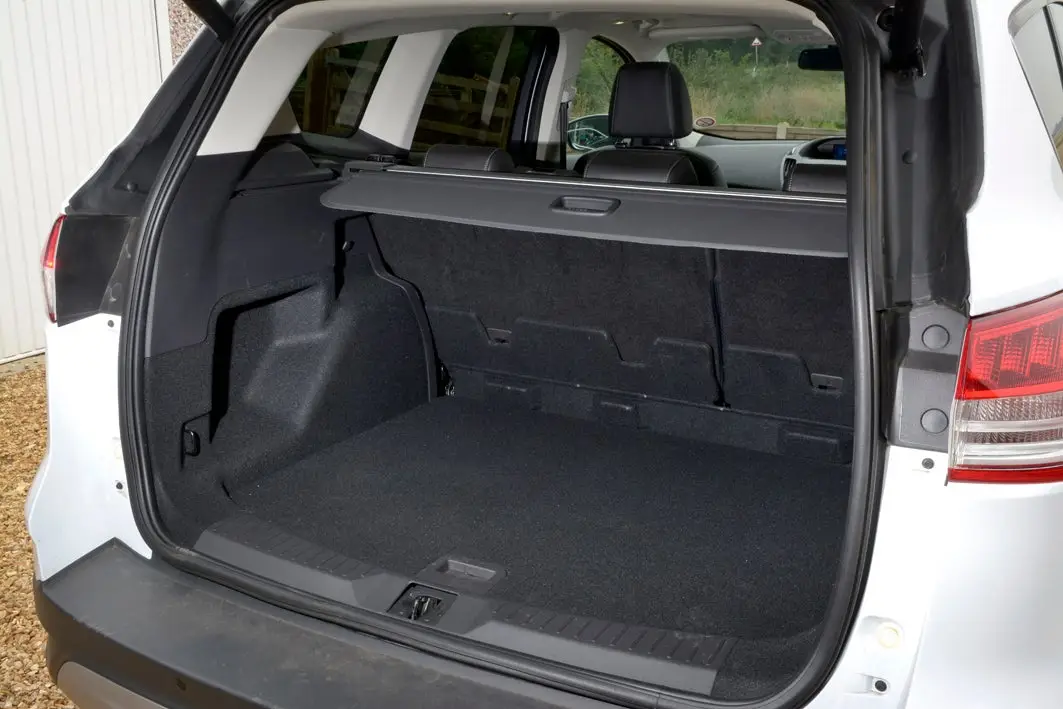
Facelifted models with the more pronounced front grille are priced from around £11,000. Here, 1.5 Ecoboost petrol engines are more commonplace, while our favoured all-rounder, the 1.5 TDCi, is around in decent numbers from £12,000. If you want a late model, looking for a Ford Approved Used model is your best bet.
Trim levels and standard equipment
The Ford Kuga model range closely follows other Ford models. The Ford Kuga Zetec is the entry-level variant, with just a passing nod to sportiness, and slightly austere trim inside. Ford Kuga Titanium includes more features as standard, and a Titanium X pack adds even more luxuries.
In 2014, the well-stocked Ford Kuga Titanium X Sport was launched. This was the highest-spec Ford Kuga yet offered, with 19-inch alloys, silver roof rails and rear privacy glass. A distinctive body styling kit was also added, with a rear spoiler and body-coloured wheelarch extensions. Inside, a premium Sony sound system was standard, along with sat-nav, electric seats and plush Torino leather upholstery.
If you thought that was upmarket, the Ford Kuga Vignale took things to another level, even offering bespoke premium paint colours. Interior trim was decadent, standard equipment was plentiful and you even got a unique hexagonal chrome grille. Around the same time, Ford launched the Ford Kuga ST-Line, which was a sporty-look model with high-gloss black trim, big wheels and lowered suspension.
Ask the heycar experts: common questions
Is the Ford Kuga a 4x4?
Are Ford Kugas good in snow?
Are Ford Kugas good on fuel?
Stay up to speed with great offers plus the latest car news and reviews
Keep me updated by email with the latest advice, news and offers from heycar.
By submitting you agree to our privacy policy

